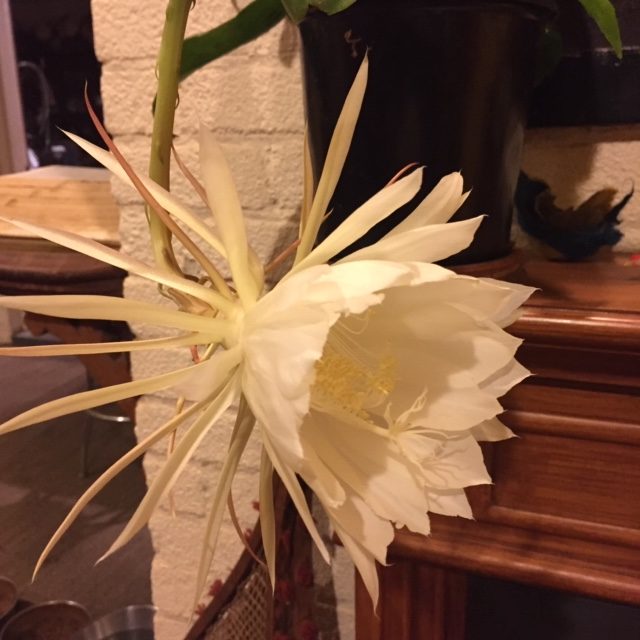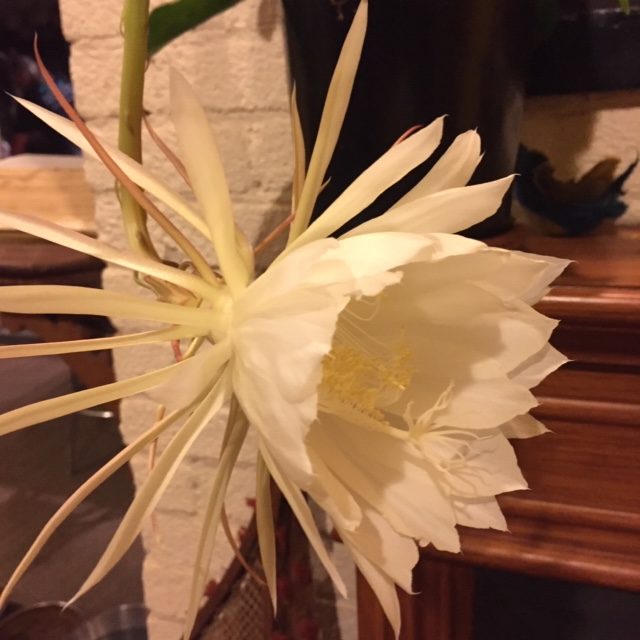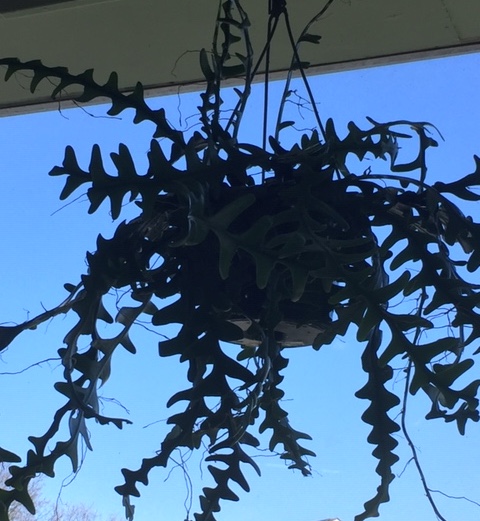-Pam Scott-

As an avid collector of all things green and growing, I am always on the lookout for plants that I find endlessly entertaining. Plants that bloom and have interesting growth habits are top on my list of favorites. I find that most epiphytic plants easily fit into the description of “endlessly entertaining”. Epiphytic, as opposed to terrestrial plants, are ones that grow on other plants. Staghorn ferns, some orchids, air plants, some bromeliads, and epiphyllum are all fascinating epiphytes worth getting to know. Many of these plants live in the organic matter that accumulates on the limbs of trees, allowing them to become hosts to a wonderful ecosystem of birds, insects, reptiles and small mammals that trade fertilizer for protection and comfort.
Two plants in the Epiphyllum family that I have been slightly obsessed with of late are Epiphyllum oxypetalum and Epiphyllum anguliger. Of the hundreds of blooming epiphyllums that grow in the wild, these two varieties and their hybrids are the most commonly and successfully cultivated as house plants.
Epiphyllum oxypetalum is commonly known as Dutchman’s Pipe Cactus, Lady of the Night, Queen of the Night, Orchid Cactus and Night-Blooming Cereus. Kindly allow me a brief rant about the use of common names instead of current botanical names… Epiphyllum oxypetalum is not an orchid, a Dutchman’s pipe or a cereus. It is, however, a shade-loving cactus. This plant shares its common names with many unrelated plants which also happen to be night bloomers with similar looking flowers but totally different culture. Which common names are used often depends on what part of the world you are from, whereas scientific botanical nomenclature is consistent throughout the world. The use of common names instead of botanical names can lead to confusion, heated discussions, and misidentification resulting in the potential to give your plant the incorrect care. Ok… end of rant.

The most spectacular thing about Epiphyllum plants, besides their impressively large sculptural wing span, is the profusion of exotic, fragrant, ephemeral blooms they put out in the middle of the night. These plants will perform their spectacular flowering show from midnight to dawn, leaving behind only dead buds as the sun rises. These varieties have been incorrectly rumored to only bloom once a year. You can imagine my surprise when I found my oxypetalum putting out an impressive display of nocturnal blooms off and on over the period of a month. Other more rare species of epiphyllum and terrestrial cactus sharing similar common names will bloom for only one night a year.
Epiphyllum angularis commonly known as Ric Rac, Zig Zag or fishbone cactus is a plant I love to see silhouetted as it hangs in a window. Its uncommonly distinctive, dramatic, zig-zagged leaves are like no other I have seen in the plant world. They are less willing to bloom than Epiphyllum oxypetalum and will need some extra coaxing with a good dose of potassium and some late winter chilling.

Both of these plants are native to the forests and jungles of Mexico, Central, and South America. They are pollinated by nectar-eating bats and bugs that only dine at night. Since these plants live in the understory of the forest, they should not be subjected to full, direct, burning sun. Indoors, an east window with cool morning sun or a bright but filtered south to west facing window would be ideal. Unlike terrestrial cacti that enjoy full sun and dry conditions, these epiphytic cacti require thorough watering once a week and thrive in high humidity. Don’t let them dry out completely during their growing period which is spring and summer.
If you move your plants outdoors in the summer you may want to water them even more often. In summer I move my epiphytes outdoors where they live hanging in a tree. There they can enjoy the dappled light and high humidity of the summer months. From that point of view they are easy to monitor as they put out their goose necked buds, and we can see what night to set the alarm in order to watch their spectacular midnight show.
These plants like being a bit root bound, so only up-pot them an inch or two at a time, rather than moving them to a much larger container. This root binding can actually promote blooming. Be aware that as you move your plant to a bigger pot this will encourage new plant growth, and these plants can get dramatically large. One of my Oxypetalums has a seven-foot wingspan!
Make sure your pots have good drainage, and never let them sit in water. When up-potting, you can use a good cactus mix or a regular potting soil mixed with orchid bark for good drainage. These plants will love a low nitrogen, high potassium/ phosphorus fertilizer with seaweed and fish emulsion in it. If your epiphyllum are not blooming and they are at least 4-7 years old, you can try giving them a chilling period above 40 degrees for 2-3 weeks. You can put them in an unheated but well lit room in late winter, making sure it doesn’t go below 40 degrees
Epiphyllums propagate easily from leaf cuttings. Let the cutting dry for a few days, allowing the cut end to callous over, then dip it in a rooting gel before putting it in loose moist potting soil. You will notice tiny rootlike hairs coming off of the leaf; these are what the plant uses to hang onto their tree limb in the wild.
You can find hundreds of fascinating and beautiful plants, as well as all the soils, pots, tools and nutrients you will need to grow them at Fifth Season Gardening. We have staff that are well-informed plant lovers who are anxious to answer any questions you may have about all things green and growing!

Natina Anderson says
Hi there, I loved your piece on the Queen of the Night. I have 1 in my greenhouse given to me by my friend 18mth ago. It has flowered about 14 times in that period. It is totally exquisite and the flowers are the most beautiful thing of beauty. I have taken the black shade cloth of my house to replace it with a lighter 1. Queenie is in the North/East cnr of the greenhouse and liked it till I changed the cloth. So now I will have to find another spot for her.Thank you for sharing your piece.
Cherie Holmquist says
I “rescued” an “orchid cactus” from a big box store several months ago. I believe it is the Epiphyllum Oxypetalum. It has quickly become one of my favorite plants! I have propagated a plant from a couple of leaves that were broken when I got it. That plant went to a friend.
I also have the angularis, which us another of my favorite “houseplants!”
Thank you for the great care tips for Epiphyllum!!
I recently ordered and received three unrooted leaves. The Carnival, Spanish Gold and Jalisco Joy!! Can’t wait for them to take root and take off -growing at their amazing rate!! I’m definitely a convert!! Look forward to learning more from your amazing site. Thank you!!
Kim Pham says
I Accidentally cut off the long leaf that was growing from the big leaf. What can I do?
brian says
Hopefully your plant will recover. Also, in the post we cover propagation techniques. With a little luck you may be able to get the leaf cutting to root and end up with two plants!
Deb says
My plants has been infested by insects the tall leaf has hold can I prune It and if so what month should I cut the tall leaf back in? ( Beginner)
brian says
You can prune these plants any time of year. Probably best to do it this time of year since it is in active growth and will recover more quickly. Best of luck!
janice welch says
my plant was a rescue while it is large i see no sighs of blums but it continues to grow what im i doing wrong
brian says
As it continues to grow that’s a good sign! It could be that your plant is still recovering and will bloom in time. Also, some varieties bloom infrequently and others more often so it’s a bit hard to say for sure. If you haven’t fertilized recently, it’s probably time to do so. Please check the post for recommendations. Best of Luck!
Craig says
I have a queen of the night plant that is probably 20 to 25 years old. I pruned it back and propogated 3 or 4 more plants from the original. Those plants are doing well and blooming new flowers. My original is not doing well and I see no signs of flowers for the last 2 years. How old can my plant survive?
brian says
Hi Craig and thanks for reaching out. We weren’t able to find any concrete data about how long they can live. It is possible that your original plant may just be recovering (slowly) from being pruned back for propagation and that it will bloom again one day. As long as you’ve got the space and patience we’d encourage you to simply give it more time!
Eric Wright says
My Lady of the night is 2-4 years old. It grows long straight tendrils in abundance. It has never flowered. Are these tall straight tendrils normal? Should I leave them alone to grow?
I’ve read everyone’s woes about their plants not flowering, so I’ll try more nitrogen in my soil. I’m just wondering about these long spikes growing profusely.
brian says
Thanks for reaching out. You can always prune some of the tendrils if you like. I think you’re right on considering fertilization. Make sure that you’ve got a good balanced fertilizer that will add P and K also! Also, take a look at the pot. As mentioned in this post, these plants do best when somewhat root-bound. Best of luck.
Audrey says
What is causing my queens to have white and black spots oh them?
brian says
Thanks for your question. It’s hard to say for sure without seeing your plant. It sounds like you could have a fungal problem. If so, we’d recommend treating with a liquid copper fungicide that is OMRI certified. We stock a version from Monterey and also a similar product from Bonide. Best of luck!
Diane says
I have had an Oxypetalum for about 25 years which came from my mother’s garden. It was a creamy white and flowered each year. I potted a leaf from this plant in a different hanging basket and it produced a bright amost burgundy flower. This year it has produced masses of small pink flowers along the leaves. It does have a big seed pod/fruit on it from last year. Why is it changing so much. It looks lie a different plant now.
brian says
This is a head-scratcher for us as well. Your leaf that you propagated should be genetically identical to its mother plant. Maybe the different conditions that the two plants are in is causing the color change. Happy to take on any suggestions from others in this comment thread to see if they might have more insight. Thanks for sharing this interesting story.
Sylvia Rosenacker says
Is it ok for my epi to get morning sun?
brian says
Thanks for your question. Remember that they are understory plants. So, a little sun should be good if it’s limited to morning hours. Consider too how intense that morning sun will be. If your plant is right next to an eastern window, it could be good to move it back a bit or to install a sheer to knock the light intensity back a bit. Best of luck!
Tammy says
My Queen of the night bloomed last year but now it is dying. And I do not know how to save it. I’m so terribly upset. I did not know what it was when my sister gave it to me and then I saw this huge bud on it and hours later a beautiful flower. I kept her in the house all winter but now she is all brown with very little green. Can I save her?
brian says
Sorry to hear this. Oftentimes after blooming plants can take a step backwards. We’d recommend pruning any brown parts to encourage the plant to focus on regeneration. With proper conditions and fertilization your plant may bounce back. Best of luck!
Heather says
My plant is very leggy, and has never flowered. It’s about 4 years old and is constantly growing, but now is showing signs on some Leaves that make me believe it’s getting too much sun. I have it on a NE window where it does get morning sun but a large tree is in front of the window which kinda filters the light. I think it’s health is declining but not sure what to do! Would love to have a video chat or call as I don’t know anyone who has any knowledge of this plant.
brian says
Hi Heather and thanks for reaching out. It’s possible that your plant is now getting a bit too much sun as the season change means that the sun’s angle on your window has changed too. If possible, it might be a good idea to move it outside for the season if you’ve got a good spot for it. Perhaps suspended from a tree branch or on a covered porch that doesn’t get direct sunlight. Best of luck!